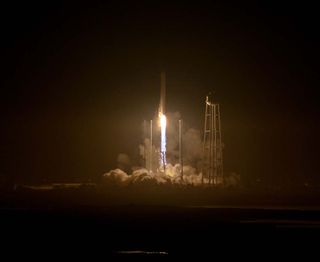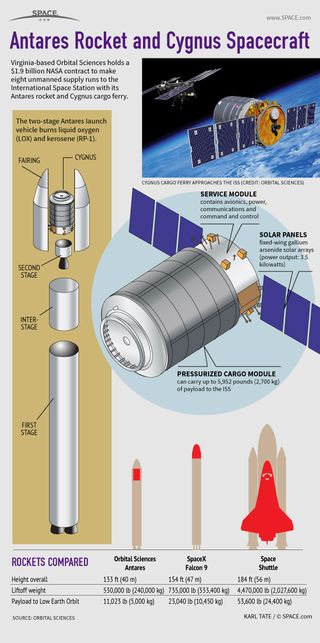Orbital ATK's Antares Rocket Returns to Flight with Gorgeous Night Cargo Launch
WALLOPS ISLAND, Va. — We have liftoff! For the first time in two years, an Orbital ATK Antares rocket has successfully launched into space, departing NASA's Wallops Flight Facility here this evening (Oct. 17) on a mission to deliver supplies to the International Space Station (ISS).
The upgraded Antares rocket soared into the night sky at 7:45 p.m. EDT (2345 GMT) today, topped with Orbital ATK's uncrewed Cygnus cargo capsule. Millions of observers along the U.S. East Coast had the opportunity to view the rocket's ascent, which was visible from as far north as Boston and as far south as central South Carolina.
After liftoff, Antares veered southeast on its way into low-Earth orbit. About 9 minutes into the mission, Cygnus entered orbit carrying its load of 5,100 lbs. (2,300 kilograms) of science experiments, hardware and other supplies for the astronauts aboard the ISS. [Photos: Antares Rocket Launches for 1st Time Since 2014]


This is a high-stakes mission for the Virginia-based commercial spaceflight company Orbital ATK. Its last attempt at launching an Antares rocket, nearly two years ago, ended in a catastrophic explosion just a few seconds after liftoff from Pad-0A here at Wallops. The current mission, titled OA-5, is Orbital ATK's sixth official cargo resupply mission for NASA, and the fourth using an Antares rocket. (The two missions immediately following the October 2014 accident employed United Launch Alliance Atlas V rockets.)
During a news conference here Saturday (Oct. 15), NASA officials and Orbital ATK representatives expressed confidence that OA-5 would go well. Dale Nash, executive director of Virginia's Commercial Space Flight Authority, said the Wallops launchpad — which cost $15 million to rebuild after the 2014 explosion — is in better shape than ever before. Nash said the OA-5 prelaunch tests went "extremely well," and that they were "two of the cleanest tests we've ever seen."
Despite the clean bill of health for Antares and the onboard Cygnus, an issue with one of the ground support cables at the launchpad just hours before launch time on Sunday (Oct. 16) forced NASA and Orbital ATK to postpone the launch by a day. A few days prior, Hurricane Nicole prompted a scrub of Thursday's (Oct. 13) planned launch as the Category 1 storm shut down Orbital ATK's tracking station in Bermuda.
Because the Antares launch date slipped several days, the Cygnus spacecraft's planned arrival now conflicts with the arrival of a Russian Soyuz spacecraft that will be delivering three astronauts to the ISS Friday (Oct. 21). Therefore, Cygnus will wait its turn, loitering in orbit until Sunday (Oct. 23), NASA officials said. [Gallery: Orbital Sciences' Cygnus Spaceship & Antares Rocket]
Sign up for the Live Science daily newsletter now
Get the world’s most fascinating discoveries delivered straight to your inbox.
Under Orbital ATK's $1.9 billion contract with NASA, the private spaceflight company will carry about 66,000 lbs. (30,000 kg) of cargo to the space station over the course of 10 missions. Among Cygnus' cargo on OA-5 are a number of science experiments, supplies and hardware for spacewalks, as well as food and clothing for the astronauts.
Today's launch was the first to use Orbital ATK's new and improved Antares 230 rocket. The updated launch system uses Russian-made RD-181 rocket engines in place of AJ26 engines, which were implicated in the October 2014 accident.
When Antares' engines ignited this evening, it took the rocket 3.6 seconds to lift off and about 8 seconds to completely exit its support structure. Shortly after liftoff, the rocket wiggled slightly. Gut-wrenching as it may have looked, this wobbling motion was nothing to worry about; the rocket was intentionally designed to wiggle to avoid placing its fiery plume directly over the transporter-erector vehicle at the launchpad, Orbital ATK general manager Mike Pinkston said at a news conference.
Once deployed in orbit, Cygnus separated from Antares and began to unfold its solar panels — a process that takes about 15 minutes. The spacecraft then revved up its propulsion system to start maneuvering toward the space station. Orbital ATK named the Cygnus flying on this flight the S.S. Alan Poindexter, in honor of the late NASA astronaut Alan Poindexter.
Cygnus should arrive at its space station destination on Sunday (Oct. 23), NASA officials said. During its trip, Cygnus will orbit Earth every 90 minutes at about 17,500 mph (28,200 km/h) while gradually increasing its altitude. When it's ready to rendezvous, a robotic grapple arm will extend from the ISS, grab Cygnus and attach or "berth" it to the space station.
After unloading the cargo, astronauts on the ISS will fill Cygnus with up to about 5,100 lbs. (2,300 kg) of "disposal cargo" — garbage, in other words. Sometime between 10 and 90 days into the mission, Cygnus will leave the space station and head back to Earth. The spacecraft and all that trash should burn up entirely upon re-entry into Earth's atmosphere. There is little to no risk that it will hit the ground, NASA officials said. But just in case, the spacecraft's trajectory during re-entry will take it to an unpopulated area to minimize any risk.
Orbital ATK is now tracking Cygnus from its mission control center in Dulles, Virginia, while NASA follows the spacecraft from the agency's Johnson Space Center in Houston.
Editor's note: If you captured an amazing photo of the Antares launch and would like to share it with Space.com for a story or gallery, send comments and images in to spacephotos@space.com.
Email Hanneke Weitering at hweitering@space.com or follow her @hannekescience. Follow us @Spacedotcom, Facebook and Google+. Original article on Space.com.

Hanneke Weitering is an editor at Liv Science's sister site Space.com with 10 years of experience in science journalism. She has previously written for Scholastic Classroom Magazines, MedPage Today and The Joint Institute for Computational Sciences at Oak Ridge National Laboratory. After studying physics at the University of Tennessee in her hometown of Knoxville, she earned her graduate degree in Science, Health and Environmental Reporting (SHERP) from New York University. Hanneke joined the Space.com team in 2016 as a staff writer and producer, covering topics including spaceflight and astronomy.
